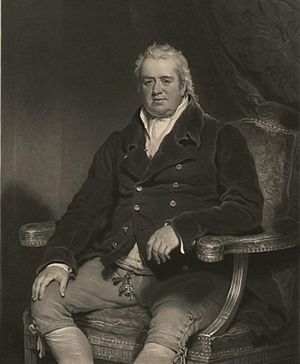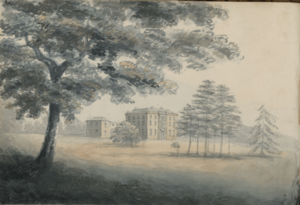Sir Robert Vaughan, 2nd Baronet facts for kids
Sir Robert Williames Vaughan, 2nd Baronet (born 29 March 1768 – died 22 April 1843), was an important Welsh landowner and a Tory politician. He was a Member of Parliament (MP) in the House of Commons for 40 years, from 1792 to 1836.
Contents
Nannau: A Grand Home
In 1800, Robert Vaughan started a big project to rebuild his home, Nannau, and the land around it. He spent a lot of money making the Georgian house look amazing. He also designed the large estate surrounding it.
He got help from Joseph Bromfield, who added a special wing and some inside features after a fire in 1808. Robert Vaughan got ideas from a book about architecture by Peter Frederick Robinson. He also added his own changes, inspired by the older Tudor architecture style.
Nannau's Huge Estate
The Nannau estate was huge, covering over 10,000 acres. Sir Robert had 55 miles of walls built around the estate and the nearby village of Llanfachreth. To do this, he used 18 horses and mules, and 9 men with carts.
He also built two farms and ten cottages on the land. Between 1820 and 1830, five arches and one lodge were built. Another lodge was named after his ancestor, Hywel Sele. He also created a deer park, many miles of carriage driveways, and a fishing pond. Sir Robert even helped rebuild the town centre of Dolgellau.
The Nannau estate was home to some famous things. Sir Robert Vaughan, who was interested in old objects (called antiquarianism), placed the 'Nannau bucket' there. This was an old Bronze Age urn found nearby.
Another famous thing was the Nannau Oak. This tree fell during a lightning storm in 1813. It was famous because it was said to be where his ancestor Hywel Sele died. The tree was known as 'Derwen Ceubren yr Ellyll', which means 'the hollow oak of the demon'. Parts of the oak were used to make special items, like a stirrup cup for his only son's 21st birthday party. This party was one of the biggest birthdays ever in Wales! In 1824, a famous white Nannau Ox, the last of its kind, was used for the coming-of-age celebrations at Nannau.
Sir Robert: A Politician
Vaughan became a Member of Parliament (MP) for Merioneth in 1792. He held this important position for a very long time, through 14 different Parliaments, until he had to retire in 1836.
He also worked with Oxford University. He led meetings for Welsh gentlemen who had studied at Jesus College, Oxford, just like he had. He continued this work until at least 1819. Later, he was appointed High Sheriff of Merionethshire for 1837–38. This was a very important local role.
Sir Robert's Family Life
Sir Robert Vaughan was the oldest son of Sir Robert Howell Vaughan, 1st Baronet. His father died just one year after becoming a baronet. Robert Vaughan, the 2nd baronet, studied at Jesus College, Oxford in 1787. He took over his father's title and estates on 13 October 1792. His father was buried at St Illtyd's Church, Llanelltyd.
Sir Robert inherited the large 12,000-acre Nannau estate and farms. He also inherited Ystum Colwyn, Meillionydd, and the Hengwrt estate. His brother, who changed his name to Edward Salesbury, inherited the Rhug estate. Edward became a Colonel in the military, leading the 1st Regiment of Foot Guards. Sadly, he died in battle in 1807. After Edward's death, his younger brother Griffith inherited the Rhug estate.
Sir Robert married Anna Maria on 23 September 1802. She was the daughter of Sir Roger Mostyn, 5th Baronet.
Before he died, Sir Robert had to sort out the family's money. There were big costs from his son's coming-of-age party. Even more, he had to take care of his brother's debts after his death. Sir Robert Williames Vaughan died in April 1843. He left his estates at Nannau, Hengwrt, Meillionydd, and Ystumcolwyn to his son. This was the last time these estates would be owned by one person.




